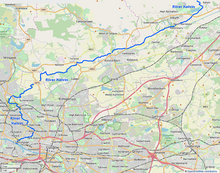geo.wikisort.org - River
The River Kelvin (Scottish Gaelic: Abhainn Cheilbhinn) is a tributary of the River Clyde in northern and northeastern Glasgow, Scotland. It rises on the moor south east of the village of Banton, east of Kilsyth.[1] At almost 22 miles (35 km) long, it initially flows south to Dullatur Bog where it falls into a man made trench and takes a ninety degree turn flowing west through Strathkelvin and along the northern boundary of the bog parallel with the Forth and Clyde Canal.
This article needs additional citations for verification. (December 2007) |
| River Kelvin | |
|---|---|
 The Kelvin flowing through Kelvingrove Park | |
 | |
| Location | |
| Country | Scotland |
| Physical characteristics | |
| Source | |
| • location | close to Banton, Scotland |
| Mouth | River Clyde |
• location | Glasgow, Scotland |
• coordinates | |
| Length | 35 km (22 mi) |

The University of Glasgow is situated by the river, in Gilmorehill. In 1892, the title of Baron Kelvin was created for physicist and engineer William Thomson, a professor at the university. The name "kelvin" for the unit of temperature, chosen in honour of Lord Kelvin, thus traces its origins to the river.
Etymology
The hydronym Kelvin is probably of Brittonic origin.[2] It may involve *celeμïn, of which the Welsh cognate celefyn means "stem, stalk",[2] or else the zero-grade of the Indo European root of that element *kl̥h1-, "rise up".[2]
Confluence
The river's first important (and considerably larger) confluence is with the Chantyclear Burn which originates from the ridge of Dullatur. It then continues its westward flow being joined by the often depleted (due to water being diverted to the canal) Shawend Burn to the west of Craigmarloch bridge. The next important tributary is the Garrel at a point south-east of Kilsyth south of Dumbreck Marsh. The Kelvin then passes through the large flood plain north of Twechar where it is fed by the Dock Water, Queenzie Burn, the Cast Burn and the Board Burn before reaching Kirkintilloch at its confluence with the more substantial waters of the Glazert and Luggie. It then flows past Torrance, meanders through Balmore Haughs, to the south of Bardowie where it joins the Allander Water, after which it takes a south-westerly direction towards Maryhill, Hillhead, through Kelvingrove Park before falling into the River Clyde at Yorkhill Basin in the city of Glasgow.[3]
Fauna
Wildlife along Strathkelvin include the grey squirrel, magpie, grey heron, dipper, cormorant, blue tit, great tit, chaffinch, common snipe, great spotted woodpecker, blackbird, redwing, carrion crow, kingfisher, mallard, goosander, roe deer, red fox, otter, water vole, American mink and brown rat.
Successive attempts at improving the quality of the water have been rewarded by the return of salmon. The river has always been home to brown trout and both species can be fished by obtaining the relevant permits.[4]
Bridges over the Kelvin

The Kelvin is bridged at several points throughout Glasgow. Most notable is the Great Western Bridge on Great Western Road in the city's West End. Below this bridge is an underground station that bears the name Kelvinbridge, a name commonly attached to the area. Other bridges include the one near the Antonine Wall at Balmuildy, Partick Bridge on Dumbarton Road, the bridge at Queen Margaret Drive, Ha'penny Bridge and several in the grounds of Kelvingrove Park.
The Kelvin Aqueduct carries the Forth and Clyde Canal over the river. It was Britain's largest when it was opened. The river is used as an overflow for the canal.
See also
- Allander Water, Allander Burn
- Kelvinhead
- List of places in East Dunbartonshire
- List of places in Scotland
References
History of Banton; William Gracie, 1995 pub. Stratkelvin district council. (Kilsyth Library, local studies)
- Robert Murray. "Source of the Kelvin (C) Robert Murray :: Geograph Britain and Ireland".
- James, Alan G. "A Guide to the Place-Name Evidence - Guide to the Elements" (PDF). Scottish Place Name Society - The Brittonic Language in the Old North. Retrieved 25 October 2018.
- Google (27 January 2017). "Map of River Kelvin" (Map). Google Maps. Google. Retrieved 27 January 2017.
- "Urban Fly Fishing on the Kelvin". Retrieved 26 April 2008.
External links
- Friends of the River Kelvin River Kelvin based charity
- River Kelvin Angling Association River Kelvin Angling Association
- Kelvin Walkway - Glasgow West End Illustrated guide to riverside walk
- Kelvin Bridges Heritage Trail by Institute of Civil Engineers Scotland
На других языках
[de] Kelvin (Fluss)
Der Fluss Kelvin ist neben dem Clyde Glasgows zweiter Fluss. Er entspringt bei Kilsyth nordöstlich von Glasgow und mündet nach 33,5 Kilometern in Partick in den Fluss Clyde. Entlang des Flusslaufes befinden sich mehrere namhafte Sehenswürdigkeiten des westlichen Teils der Stadt Glasgow, darunter der Botanische Garten, die Universität Glasgow, der Kelvingrove Park und das Kelvingrove Art Gallery and Museum.- [en] River Kelvin
[es] Río Kelvin
El Kelvin es el segundo río de Glasgow tras el Río Clyde. Fluye junto al Jardín Botánico, la Universidad de Glasgow, el Kelvingrove Park, y el Kelvingrove Art Gallery and Museum. En referencia a este río William Thomson se convirtió en Barón de Kelvin por la reina Victoria. Y en honor del físico, se llamó a la Escala absoluta de temperaturas como Escala Kelvin. También, en su honor se llamó kelvin a la unidad de la temperatura termodinámica, https://web.archive.org/web/20181223053741/https://www.bipm.org/en/measurement-units/[it] Fiume Kelvin
Il Kelvin è un fiume scozzese che scorre nei pressi di Glasgow. Lungo circa 35 km, è il principale affluente del Clyde[1], il corso d'acqua più importante della città.[ru] Келвин (река)
Келвин (англ. Kelvin, гэльск. Cheilbhinn) — река на юго-западе Шотландии. Является притоком реки Клайд, впадает в Клайд на территории Глазго, пройдя через север и северо-восток города. Длина реки составляет 35 км, площадь бассейна — 350 км²[1].Другой контент может иметь иную лицензию. Перед использованием материалов сайта WikiSort.org внимательно изучите правила лицензирования конкретных элементов наполнения сайта.
WikiSort.org - проект по пересортировке и дополнению контента Википедии